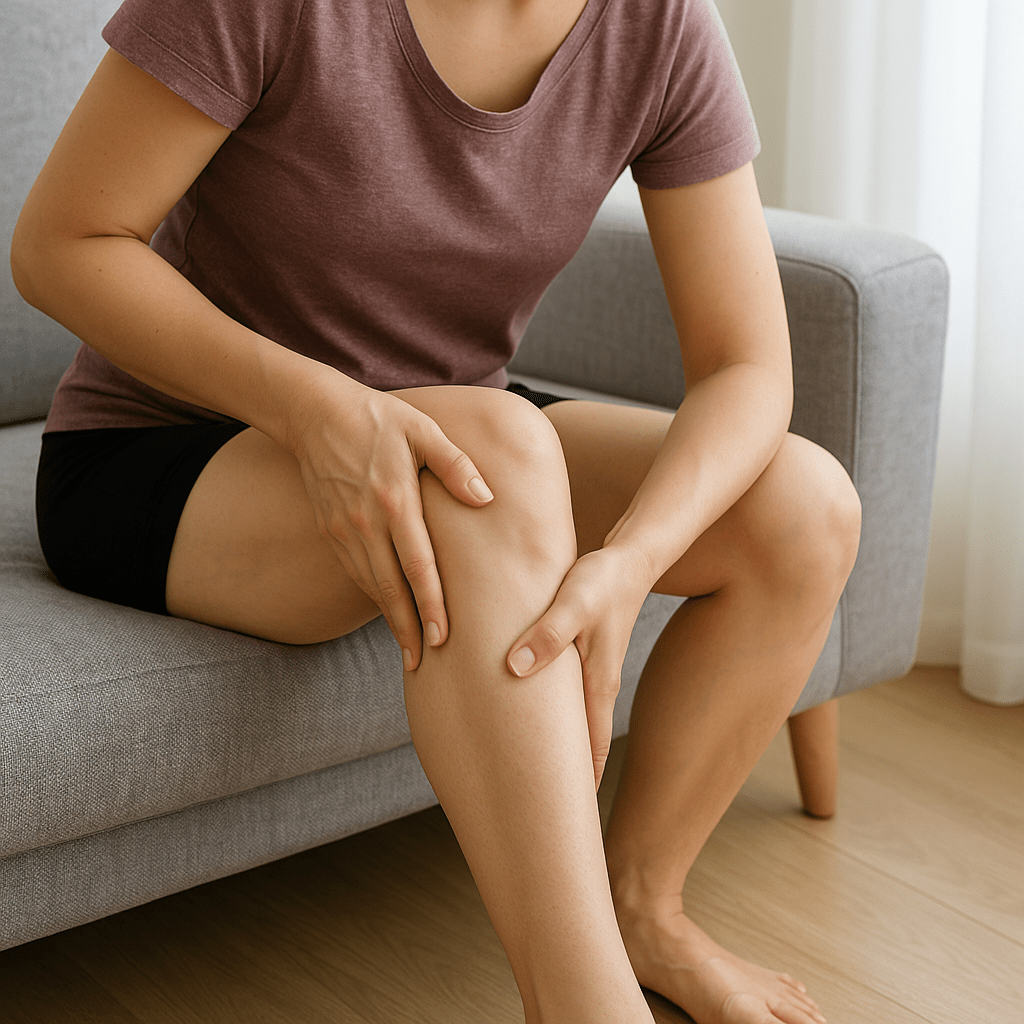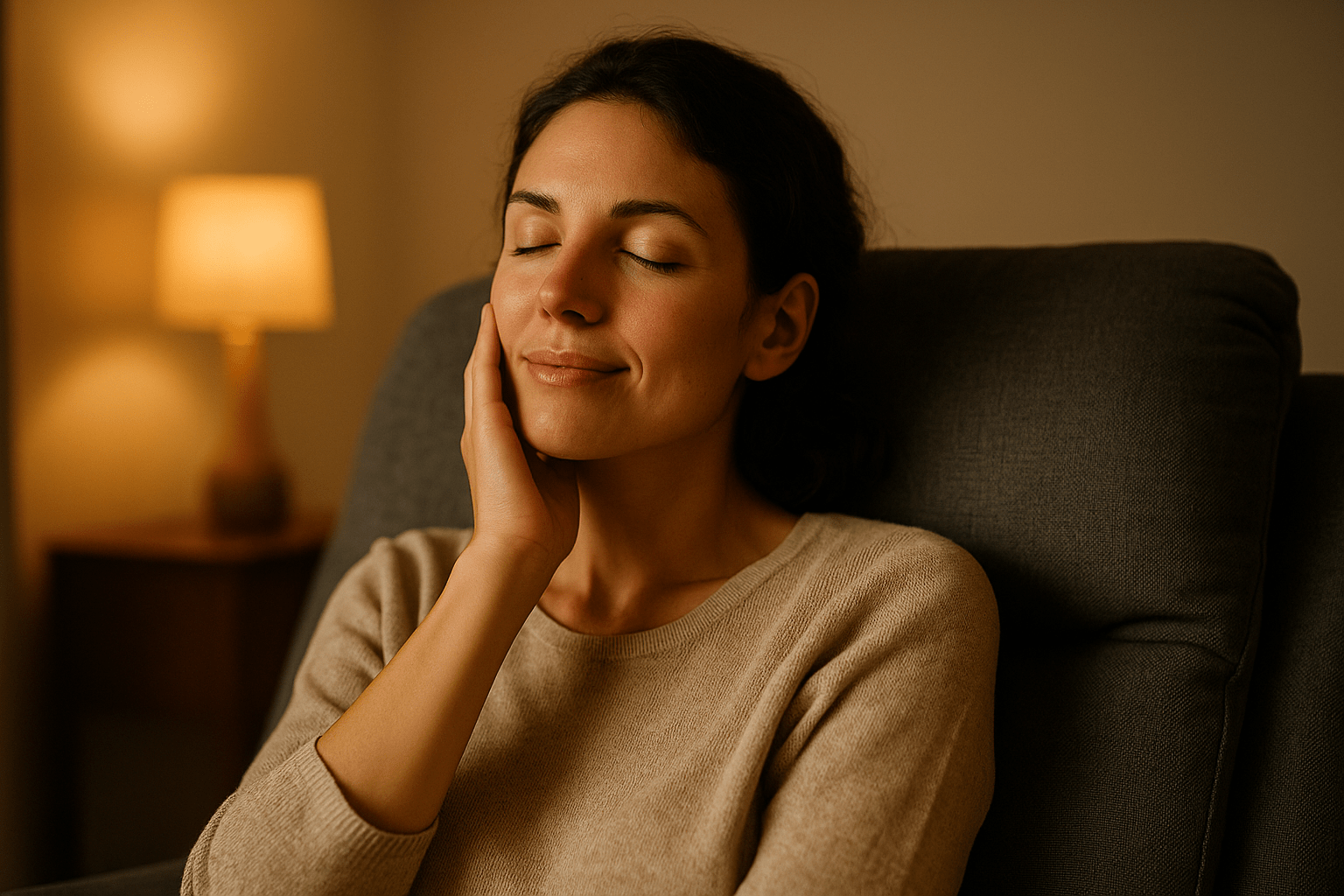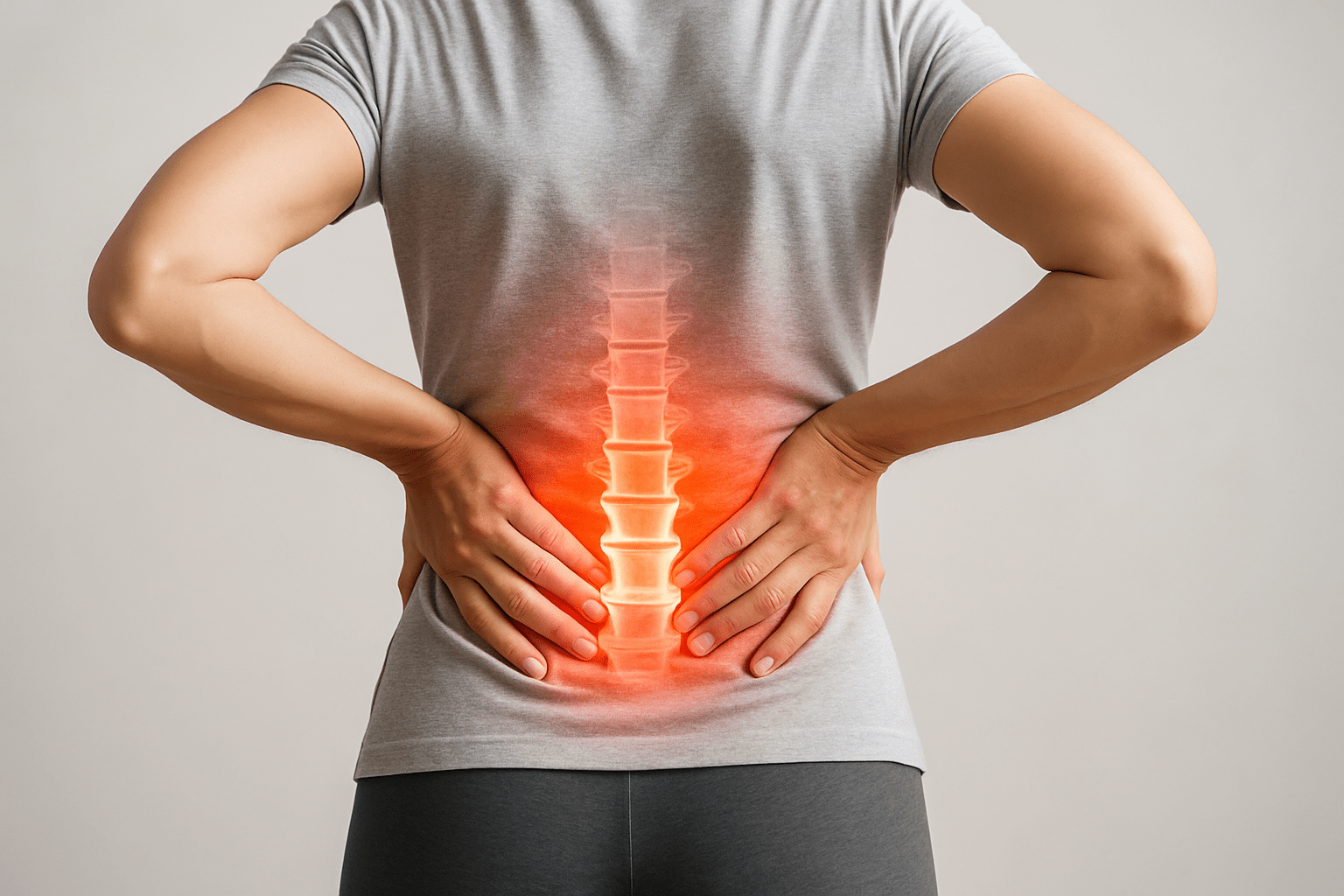Muscle pain in the legs: causes and prevention
Have you ever tried standing on one leg for longer? Maybe in yoga, maybe for fun while waiting at traffic lights? After a few seconds your calf starts to tremble, after a minute your muscles start to pull - and that's when the pain kicks in. This is no problem for flamingos. They sleep like this, sometimes for hours, without a hint of cramp. For us humans, on the other hand, it's a real feat of strength. Our legs are made to carry us, to keep us moving, to get us from A to B, but they acknowledge overloading, lack of exercise or nutritional deficiencies...


Have you ever tried standing on one leg for longer? Maybe in yoga, maybe for fun while waiting at traffic lights? After a few seconds your calf starts to tremble, after a minute your muscles start to pull - and that's when the pain kicks in.
This is not a problem for flamingos. They sleep like this, sometimes for hours, without a hint of cramp. For us humans, on the other hand, it's a real feat of strength. Our legs are made to carry us, to keep us moving, to get us from A to B, but they very quickly respond to overloading, lack of exercise or nutritional deficiencies with pain or cramps.
Leg pain and calf cramps are among the most common complaints of all. Millions of people in Germany are familiar with them - sometimes as an annoying ache after a long day at work, sometimes as a sudden, stabbing pain in the middle of the night. And as harmless as they may seem at first, they can really restrict our everyday lives.
In this article, we get to the bottom of the causes of leg pain and calf cramps, show you how to recognize them, which measures really help and why massages - whether classic or with a modern massage chair - can be more than just wellness.
How common is leg pain and calf cramps?
So this much is clear: leg pain and calf cramps are not rare side effects, but something that almost everyone has experienced. But how common are they really? Is it just a few isolated complaints - or are we talking about a phenomenon that affects entire age groups and shapes the everyday lives of many people?
When your calf cramps painfully in the middle of the night or your legs are heavy and tired after a long day at work, it often feels very individual. But the figures show: Leg pain is a real common ailment.
According to surveys by the Robert Koch Institute around 27 to 30 percent of adults in Germany state that they have experienced leg pain within just 24 hours. The number increases significantly with age: almost half of all women and more than a third of men between the ages of 65 and 79 regularly report acute joint and leg pain. This makes it one of the most common health complaints in everyday life.
Also calf cramps are also widespread, and not just among older people. Even young adults are familiar with the sudden, stabbing pain. Over 90 percent say they experience cramps at least occasionally. However, the frequency increases significantly over the years, especially at night: While younger people are usually only rarely affected, many older people complain of being regularly torn from sleep by cramps.
This data makes it clear that leg pain and calf cramps are not an isolated case and not a trifle. They affect millions of people across all age groups. Reason enough to take a closer look: Where do these complaints actually come from?
Causes of muscle pain in the legs and calf cramps
Leg pain and calf cramps have many faces and just as many causes. Sometimes it's sore muscles after an intensive sports session, sometimes it's a long car journey where your legs have been kept still for hours. Sometimes there is also a mineral deficiency behind it or an illness that impairs blood circulation. To understand the symptoms, it is worth taking a closer look at the most common triggers.
Muscle pain in the legs
Muscle pain is often simply caused by overload. Anyone who puts more strain on their legs than they are used to often feels it the next day: micro-injuries in the muscle fibers lead to the familiar ache we call muscle soreness. But also muscular imbalances are also a problem. If we sit a lot, certain muscles are weakened while others are overloaded. This causes tension and pain.
Another factor is the lack of exercise. Sitting for hours at the office or at home can disrupt blood circulation, shorten muscles and also cause pain. Added to this are Injuries or poor posturefor example due to incorrect footwear or anatomical features such as different leg lengths, which change the statics of the body and put permanent strain on the legs.
Calf cramps
The situation is different with the often painful calf cramps. Here the mineral balance plays a key role. Magnesium, potassium and calcium in particular are crucial for muscle function. If they are lacking, the tendency to cramp increases. Also lack of fluids - caused by heavy sweating or not drinking enough, for example - can also be a trigger.
Particularly common are the so-called nocturnal calf cramps. During sleep, the magnesium level drops slightly, the muscles are less active and involuntary contractions occur more easily. Exercise-induced cramps on the other hand, occur during or after intense physical activity: The muscle is fatigued, electrolytes are depleted, and the sudden cramp forces it to stop.
Added to this are other risk factorsthat can promote cramps, for example pregnancy, certain medications, alcohol, diabetes or circulatory disorders.
Nocturnal vs. exercise-induced cramps - the comparison
Both forms feel similar, but differ in their causes and the circumstances of their occurrence. While nocturnal cramps seem to occur "out of nowhere" and disturb the night's sleep, cramps caused by exertion are often a warning signal from the body: "Stop, I'm overloaded!"
|
Feature |
Nocturnal calf cramps |
Exercise-induced calf cramps |
|
Time |
Especially at rest and during sleep |
During or directly after physical activity |
|
Causes |
Mineral deficiency, fluid deficiency, hormonal fluctuations, illnesses |
Muscle fatigue, overload, loss of electrolytes, insufficient warm-up |
|
Risk factors |
Age, pregnancy, sedentary lifestyle, alcohol |
Intensive strain, unusual training, muscle injuries |
|
Symptoms |
Sudden, severe pain, sleep disturbance, muscle stiffness |
Pain or cramping during movement, abrupt end to activity |
Symptoms and restrictions
Not all leg pain is the same. Some sufferers describe it as a dull aching, others feel a stabbing or pressing pain. The symptoms often occur after physical exertion, for example after a long day at work, a hike or an intensive sports session. However, sitting for long periods in the office or in the car can also cause the same symptoms. Particularly insidious: the legs often feel heavy, tired or downright "blocked" even before the actual pain sets in.
Calf cramps on the other hand, have a completely different character. They occur suddenly and without warning. Within a few seconds, the muscles contract painfully, the calf hardens noticeably and the pain can be so severe that it literally pulls you out of your sleep. Even though the cramp is relieved after a few minutes, there is often a dull aching that makes the muscle sensitive for hours afterwards.
The consequences are often more serious than you might think. Anyone who regularly struggles with leg pain or cramps suffers not only from the acute pain, but also from the restrictions in everyday lifeSport becomes a torture, long walks a challenge and night-time cramps lead to sleep disorders, which in turn cause tiredness and concentration problems the next day. Seemingly "harmless" complaints can quickly turn into a vicious circle that noticeably restricts quality of life.
What helps against muscle pain in the legs and calf cramps?
If a cramp suddenly shoots up in your calf or your legs ache after a long day, what you need above all is quick and simple help. Particularly effective in such moments is gentle stretching. If you pull your foot upwards until it points towards your shin, you can stretch the cramped calf muscles. This simple movement is often enough to relieve the cramp. Stretching can also help with general muscle pain, as it takes the tension out of the tissue and makes the muscles more flexible again.
Equally beneficial is warmth. A warm bath, a hot water bottle or a visit to the sauna relax the muscles and stimulate blood circulation. Heat can have a particularly liberating effect on pain caused by tension or prolonged sitting. It helps the muscle to loosen up and at the same time promotes regeneration.
Another central role is played by fluid supply. Muscles need a balanced ratio of minerals such as magnesium, potassium and calcium in order to work smoothly. Anyone who drinks too little or loses a lot of fluid during sport quickly upsets this sensitive balance. The result: a higher susceptibility to cramps. Drinking regularly throughout the day, preferably water or unsweetened tea, stabilizes the electrolyte balance and relieves the muscles.
Also exercise is a simple but often underestimated remedy. After a cramp or in the case of dull pain, a short walk or shaking out your legs can stimulate circulation and promote blood flow. If you also elevate your legs, this facilitates the return flow of blood and reduces the feeling of heaviness that is often associated with leg pain.
The situation is different for acute injuries. The rule here is: cold instead of heat. A cold pack or cold water help to reduce swelling and inflammation and alleviate pain.
In the long term, many complaints can be prevention can be avoided. Regular exercise, whether in the form of walking, cycling or targeted strength training, keeps the muscles supple and strong. It is particularly important to warm up the muscles before exercise and to stretch them after training. This prevents injuries and overloading.
Also the diet also plays a decisive role in preventing cramps. Magnesium-rich nuts, potassium-rich bananas or calcium-rich dairy products are valuable building blocks for stable muscle function. Drinking enough fluids also helps the muscles to remain efficient.
Last but not least, the everyday life plays a major role. Sitting in the office for hours on end, crossing your legs or monotonous strains promote pain and cramps. Small breaks in which you stand up, move around or do a few stretching exercises are like a small investment in your own health - with a big effect.
All these measures show: Leg pain and calf cramps are not a fate that you have to accept. With the right actions in acute cases and a conscious lifestyle, the symptoms can be significantly reduced and sometimes even avoided altogether.
Massage as a therapy option
As helpful as exercise, stretching and a balanced diet are, sometimes the muscles simply need external support. external supportto really loosen up. This is exactly where massage comes in. It is one of the oldest methods of treating pain and tension and is still one of the most effective ways of relaxing muscles and promoting their regeneration.
A classic massage works on several levels at once. Targeted pressure and stroking movements improve blood circulation in the tissue. This ensures that more oxygen and nutrients reach the muscles and at the same time waste products such as lactic acid are removed more quickly. Hardened fibers are loosened, tension is released and the sensation of pain is noticeably reduced. Studies show that regular massages can significantly reduce pain in the lower back and leg area, especially when combined with exercise therapy and stretching exercises.
In addition to the classic hand massage massage devices and modern massage chairs are becoming increasingly important. They can be used regularly in everyday life without the need for an appointment with a physiotherapist. A leg massager, for example, wraps around the calves, exerting rhythmic pressure and simulating the work of experienced hands. This promotes the venous return flow of blood and relieves tired, heavy legs. Also EMS deviceswhich work with gentle electrical impulses, can also target and train the muscles, especially if there is a lack of exercise in everyday life.
A massage chair combines various techniques in a single device. Many models offer special programs for legs and calves, in which air cushions build up and release pressure while rollers massage the muscles. The spectrum ranges from gentle Shiatsu movements to intensive deep tissue massage. This makes massage not just a moment of relaxation, but a real preventative measure against tension, pain and cramps.
You can find out more in our further articles and product pages:
Massage is therefore much more than just a wellness treatment. It can be a crucial component in the prevention and treatment of leg pain and calf cramps, especially if it is used regularly and in a targeted manner.
Home remedies & lifestyle
In addition to targeted therapies, there are a whole range of simple measures that can be surprisingly effective in everyday life. It is often small routines that ensure that muscles remain relaxed and cramps do not occur in the first place.
A classic are warm applications. A warm foot bath in the evening, a hot water bottle on the thighs or a red light lamp on the calves are almost like a reset for tense muscles. The heat stimulates blood circulation, improves the supply of oxygen to the tissue and ensures that hardened muscle fibers become supple again. In the case of acute injuries or swelling, however, as mentioned above, the opposite is required: Cold. A cold pack or cold compresses slow down inflammation and relieve pain quickly and effectively.
Also the diet also has a direct influence. Magnesium, potassium and calcium are crucial minerals for healthy muscle function. If you regularly include foods such as nuts, seeds, green leafy vegetables, bananas or wholegrain products in your diet, you support the body's natural balance. If there is a proven deficiency, dietary supplements can be useful, but in most cases a balanced diet is sufficient.
Not to be underestimated is the effect of healthy everyday habits. Alcohol, nicotine and too much caffeine can hinder the absorption of important minerals and put additional strain on the muscles. A conscious approach to these substances helps to reduce the risk of cramps. The right footwear also plays a role: shoes that constrict the feet or change the posture can permanently strain the leg muscles and promote pain.
Another key lies in the balance between stress and recovery. If you sit all day, you should take regular exercise breaks. Even a short walk across the room or a few simple stretching exercises can make all the difference. Conversely, people who do sport also need sufficient rest periods so that their muscles can regenerate.
And finally, if symptoms occur regularly or are very severe despite all these measures, they should be have them checked out medically. Sometimes seemingly harmless leg pain has a more serious cause, such as a circulatory disorder or a neurological disease that needs to be treated specifically.
Evidence check: Magnesium and co.
Magnesium is probably the first thing that comes to many people's minds when it comes to calf cramps. Pharmacies, drugstores and supermarkets are stacked with preparations that promise quick relief. But is it really worth taking them or is it more of a persistent myth?
The scientific data is sobering. Large meta-analyses and Cochrane reviews show that magnesium has no significant effect on most people with so-called idiopathic calf cramps, i.e. cramps without an identifiable cause. In other words, studies show that taking magnesium or not makes hardly any difference to the frequency and severity of cramps. The current S1 guideline "Crampi/muscle cramp" also emphasizes that there is insufficient evidence of effectiveness.
Nevertheless, doctors sometimes recommend an attempt at therapy with magnesium. This is because the mineral is generally well tolerated and side effects such as mild digestive problems usually remain harmless. In certain situations, such as in cases of proven deficiency, during pregnancy or in dialysis patients, targeted supplementation may make sense. However, this is not an "all-purpose solution", but rather the elimination of a specific deficiency.
Otherwise, the guidelines rely primarily on non-drug measures such as regular stretching, physiotherapy exercises and a balanced diet. For particularly stubborn cases, substances such as quinine are also available in medicine, but only under strict medical supervision, as relevant side effects can occur.
So the conclusion is: magnesium is not a miracle cure for calf cramps. It can help in individual cases, but the most effective remedies remain exercise, stretching and a healthy lifestyle. If you still want to give it a try, you should do so consciously and not rely on the effect of a tablet alone.
Light legs instead of a heavy load
Although leg pain and calf cramps are widespread, they do not have to be put up with. If you know the causes, you can take targeted action, be it through stretching in acute cases, more exercise in everyday life, a diet rich in minerals or soothing warmth. Massages, whether traditional, with equipment or in a modern massage chair, are also a valuable support to relieve the muscles and prevent complaints in the long term.
And that brings us back to our animal role model: standing on one leg is no problem for flamingos, they remain relaxed and calm, whereas we humans would get cramps after just a few seconds. But with the right combination of prevention, a healthy lifestyle and modern support, we too can give our legs back some of that lightness.
How to turn heavy legs into light legs again step by step light legsthat reliably carry us through life.
⚠️ Important note
This article does not replace a medical diagnosis or treatment. If you have persistent or severe symptoms, please consult a doctor or physiotherapist.
Great - here is the complete list of sources in blog-friendly format, numbered and with clickable hyperlinks:
Sources
-
Biolectra Magnesium - Calf cramps: causes, treatment and tips
-
Wörwag Pharma - Nocturnal calf cramps: How you can prevent them
-
Loges - Overloading and the consequences of incorrect loading in sport
-
Deutsche Familienversicherung - Calf cramps: causes, diagnosis, treatment
-
Apotheken-Umschau - Calf cramps: causes, treatment, prevention
-
Utopia - Muscle pain in legs and thighs: These home remedies help
-
Bluetens - Electrostimulation: The solution for calf cramps?
-
Statista - Distribution of pain in Germany by body region and age
-
Gelenk-Klinik - Calf cramps: What causes them and what helps?
-
Gefäßchirurgie Siegen - Calf cramps can be an early warning sign of PAD
-
Consumer advice center - Magnesium during sports: Cramp let up?
-
Pharmazeutische Zeitung - Muscle cramps: Guideline recommends stretching and magnesium
-
Test.de - Magnesium against cramps: Do the minerals also have a preventive effect?
-
Thieme Connect - Muscle cramps: Half-knowledge versus evidence

Co-founder and Managing Director of Massage Chair World. With his expert knowledge and industry expertise, he helps private individuals and companies to find the right massage chairs for relaxation, health and vitality. The individual expert advice is provided both by telephone or video chat, as well as in the exhibition outside Stuttgart.



